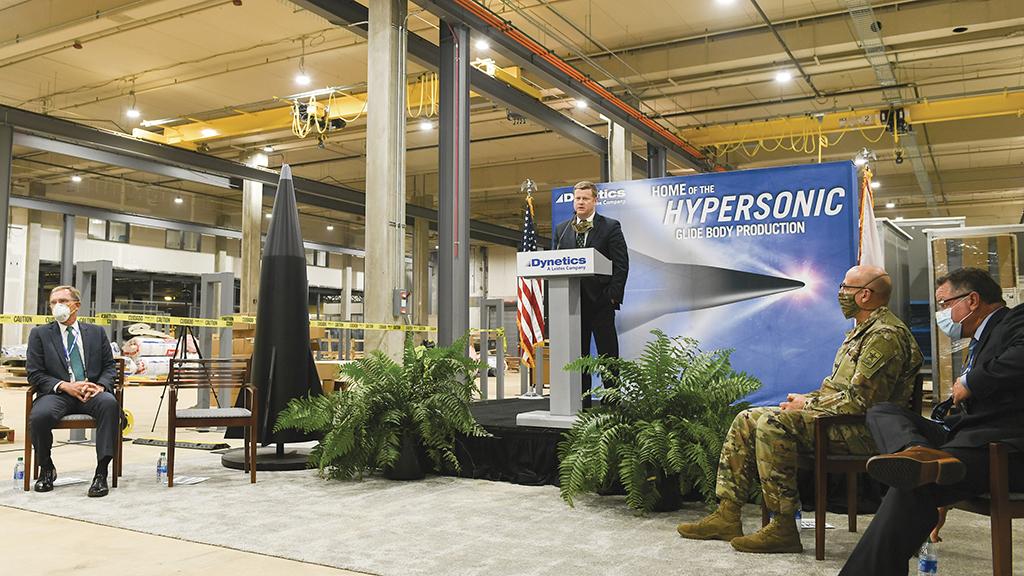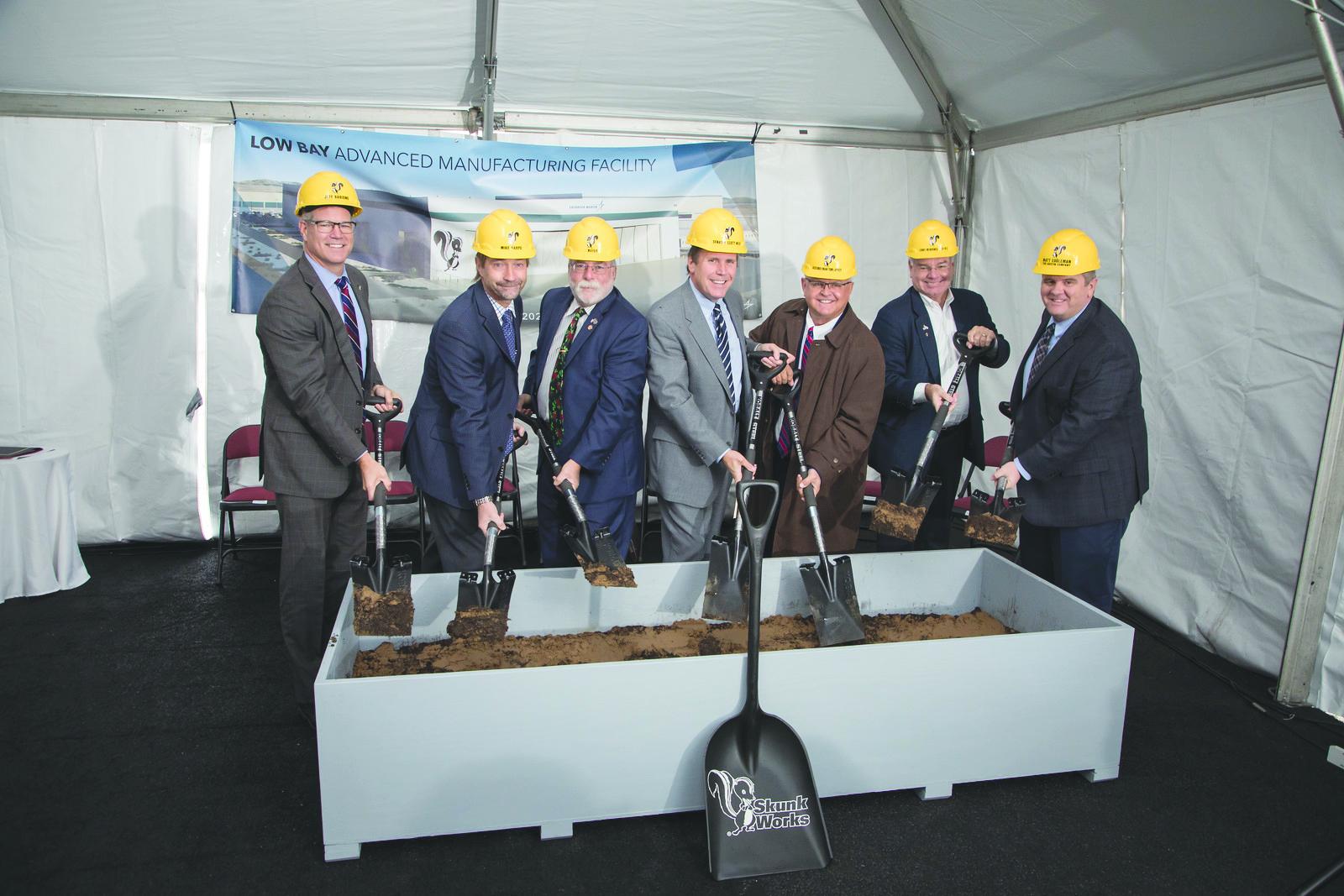
Another first in U.S. hypersonic history will take place in November, but not in a wind tunnel nor during a flight test. As military orders shift from minuscule batches of experimental craft to mass-produced missiles, Huntsville, Alabama-based Dynetics will open the first U.S. factory publicly assigned to deliver hundreds—perhaps even thousands—of hypersonic glide vehicles (HGV) during the next several years.
- Dynetics facility opens in October
- Lockheed and Aerojet also add production capacity
The Defense Department’s $10 billion plan to field at least three different HGV programs by 2025 has fueled rapid development of a new industry sector. The Air Force’s AGM-183A Air-Launched Rapid Response Weapon (ARRW) is scheduled to enter service at the end of 2022, followed by the Army’s Long-Range Hypersonic Weapon (LRHW) in 2023 and the Navy’s Intermediate-Range Conventional Prompt Strike (IRCPS) in 2025. As the military’s chosen weapon system integrator for all three programs, Lockheed Martin is the clear industrial leader of a nascent HGV market with two geographic centers: Huntsville and Palmdale, California.
On the heels of the first wave of HGV programs, the Air Force plans to start developing another arsenal of scramjet-powered hypersonic cruise missiles. The Future Hypersonics Program seeks to develop a follow-on to the Hypersonic Air-Breathing Weapon Concept (HAWC), and the newly revealed Mayhem program by the Air Force Research Laboratory seeks to develop a demonstrator for an advanced air-breathing propulsion system.
In Huntsville, Dynetics will assemble the Common Hypersonic Glide Body (CHGB) for the Army’s ground-launched LRHW and the Navy’s IRCPS, then ship the completed gliders to a nearby Lockheed facility. Lockheed’s workers will integrate the CHGB onto a common two-stage, 34.5-in.-dia. missile. The ground-launched version will then be delivered to a new Army artillery unit, and the Navy version will be inserted into a special launch system in development for Virginia-class submarines.
The Air Force’s industrial plans for the ARRW are less clear, but the city of Palmdale announced last December that Lockheed plans to open a new 208,000-ft.2 Low-Bay Advanced Manufacturing Facility in 2021 on the Skunk Works campus, which is also known as Site 10 within the Air Force’s highly secretive Plant 42 complex. The ARRW all-up round includes a smaller-diameter, single-stage booster with an advanced high-lift-to-drag-ratio HGV front end.

By contrast, the Army has been far more public about the industrial plans for the CHGB front ends for LRHW and IRCPS. In August 2019, the Army awarded Dynetics a nearly $352 million contract to deliver the first 20 CHGBs, which will support a series of LRHW and IRCPS flight tests starting in 2021.
Assembly of the first glide body has begun in Albuquerque, New Mexico, the home of Sandia National Laboratories. The CHGB is a derivative of the Sandia-manufactured Advanced Hypersonic Weapon program, which itself was based on the Sandia Winged Energetic Reentry Vehicle. Dynetics is technically the supplier for the first CHGB, but its workers are now shadowing Sandia’s experienced team in Albuquerque. The Sandia team will then travel to Huntsville this fall, where they will shadow Dynetics staff as they assemble the second CHGB.
“The glide body itself is a complicated beast,” says Paul Turner, Dynetics’ hypersonic program manager. “There are tolerances that are very tight in some locations.”
To support the assembly of the second CHGB, Dynetics plans to open the production area in the new Huntsville facility as part of Phase 1 operations in October, Turner says. After securing a certificate of occupancy at a location adjacent to the former Mid-City Mall, Dynetics will be able to start moving heavy equipment, including test chambers, into the production area. Phase 2 will open a high-bay area for final integration and testing, which is scheduled to be completed in mid-December.
A network of suppliers will be feeding subassemblies into the Dynetics production line. The Army will deliver the critical thermal protection system, which is in development under a separate contract. General Atomics Electromagnetic Systems is a subcontractor to Dynetics, producing “a couple of subassemblies” along with the cables for the glide body, Turner says. Raytheon Technologies is responsible for delivering the control module for the CHGB’s four elevon-based flight control surfaces.
“We are building all of the other avionics components within our main campus area” in another area of Huntsville, Turner says. “Those will be delivered to the Mid-City area for final testing, integration and assembly into the glider. In order to be successful, one company can’t do it all. We went through and figured out who has the expertise in the right areas. And we are using that expertise and each other’s strengths to ensure that we deliver what we say we will.”
Anticipating a huge surge in demand for hypersonic propulsion systems, both boosted and air-breathing, Aerojet Rocketdyne is systematically expanding existing manufacturing sites and adding new capabilities through growth and acquisition.
“We’ve invested in the infrastructure and the capital to provide a broad range of capabilities to support hypersonics in the areas of scramjets, solid rocket motor boosters, warheads and targets,” says Tyler Evans, senior vice president of the company’s Defense Business Unit. “We’ve co-located similar methods and manufacturing skills in order to leverage economies of scale, and we’ve created computational tools that improve our ability to repeat and develop incremental improvement.”
Although many of the offensive and defensive hypersonic efforts the company is currently involved in are still developmental in nature, they each provide the potential basis for substantial follow-on operational programs with high production volumes. These range from DARPA’s Glide Breaker and Operational Fires (OpFires) programs to the Advanced Full-Range Engine TBCC propulsion system and the HAWC with Lockheed Martin.
Some of the boosted initiatives have nearer-term production potential than the air-breathing programs. In July, for example, Aerojet Rocketdyne revealed it had successfully completed cold gas tests of the OpFires propulsion system, marking another milestone toward potential transition of the DARPA-led effort to create an operational production version of the ground-launched hypersonic tactical missile. Developed with Lockheed Martin and the U.S. Army, the OpFires missile is due to begin flight tests in 2022.
Much of the initial industrialization focus has been on expanding booster production capability at sites such as the advanced manufacturing facility (AMF) at Huntsville, which opened in 2019, and the follow-on engineering, manufacturing and development (EMD) facility in Camden, Arkansas. In addition to hypersonic work, the 136,000-ft.2 AMF is producing solid rocket motor cases and related hardware for Standard Missile-3, Terminal High-Altitude Area Defense and the Air Force’s next-generation Ground-Based Strategic Deterrent program (GBSD).
Aerojet Rocketdyne says the Camden expansion builds on the company’s decades-long history of solid rocket motor production at the site. “The EMD was specifically designed to serve as the developmental gateway to future large solid-rocket-motor product opportunities, to include GBSD, hypersonics, missile defense targets and small launch vehicles,” it adds.
But with the ramp-up in air-breathing hypersonic weapons and the beginning of new acquisition programs such as the Air Force’s recently disclosed scramjet-powered cruise missile HAWC follow-on, the company is also growing new cost-cutting additive-manufacturing capabilities. Leading this drive was the 2019 acquisition of Florida-based additive-manufacturing specialist 3D Material Technologies (3DMT), which is designed to lower Aerojet Rocketdyne’s production costs across its range of solid and liquid rockets as well as scramjets. Additive manufacturing is “integral to our solution,” Evans says.
As the developer of the scramjet engine for the Air Force’s Boeing X-51 in the 2000s, Aerojet Rocketdyne aims to capitalize on its experience of being the first U.S. manufacturer of a serially produced air-breathing hypersonic propulsion system. “The X-51 was a propulsion demonstrator that showed we could tame the science of supersonic combustion, and it did that. And so, 10 years later, we’re focused on making scramjets practical, making them repeatable, making them affordable,” he adds.
The 3DMT is a key element of the plan, Evans says. “That’s really [based on] having the tools and methods and the capabilities to repeat and affordably produce what we demonstrated 10 years ago. Additive manufacturing gets talked about a lot out in aerospace and defense,” he adds. “Since the X-51, as we’ve looked at the challenge of practicality, additive manufacturing has really proved to be a disruptive enabler of cost improvement and schedule improvement.”






